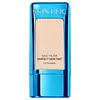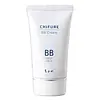What's inside
What's inside
 Key Ingredients
Key Ingredients

 Benefits
Benefits

 Concerns
Concerns

 Ingredients Side-by-side
Ingredients Side-by-side

Water
Skin ConditioningCyclopentasiloxane
EmollientCI 77891
Cosmetic ColorantPropylene Glycol
HumectantTrimethylsiloxysilicate
EmollientDimethicone
EmollientPropylene Glycol Dicaprylate/Dicaprate
EmollientIsononyl Isononanoate
EmollientPolymethylsilsesquioxane
Butylene Glycol
HumectantCI 77492
Cosmetic ColorantGlycerin
HumectantLauryl PEG-10 Tris(Trimethylsiloxy)Silylethyl Dimethicone
EmulsifyingSqualane
EmollientVinyl Dimethicone/Methicone Silsesquioxane Crosspolymer
Tridecyl Trimellitate
EmollientMagnesium Sulfate
Silica
AbrasivePhenoxyethanol
PreservativeSorbitan Sesquiisostearate
EmulsifyingCI 77491
Cosmetic ColorantDimethicone/Vinyl Dimethicone Crosspolymer
Skin ConditioningPolysilicone-11
Triethoxycaprylylsilane
Aluminum Hydroxide
EmollientQuaternium-18 Bentonite
Betaine
HumectantPanthenol
Skin ConditioningCI 77499
Cosmetic ColorantEthylhexylglycerin
Skin ConditioningMethicone
EmollientPentaerythrityl Tetra-Di-T-Butyl Hydroxyhydrocinnamate
AntioxidantSynthetic Fluorphlogopite
Tocopherol
AntioxidantWater, Cyclopentasiloxane, CI 77891, Propylene Glycol, Trimethylsiloxysilicate, Dimethicone, Propylene Glycol Dicaprylate/Dicaprate, Isononyl Isononanoate, Polymethylsilsesquioxane, Butylene Glycol, CI 77492, Glycerin, Lauryl PEG-10 Tris(Trimethylsiloxy)Silylethyl Dimethicone, Squalane, Vinyl Dimethicone/Methicone Silsesquioxane Crosspolymer, Tridecyl Trimellitate, Magnesium Sulfate, Silica, Phenoxyethanol, Sorbitan Sesquiisostearate, CI 77491, Dimethicone/Vinyl Dimethicone Crosspolymer, Polysilicone-11, Triethoxycaprylylsilane, Aluminum Hydroxide, Quaternium-18 Bentonite, Betaine, Panthenol, CI 77499, Ethylhexylglycerin, Methicone, Pentaerythrityl Tetra-Di-T-Butyl Hydroxyhydrocinnamate, Synthetic Fluorphlogopite, Tocopherol
Water
Skin ConditioningCyclopentasiloxane
EmollientButylene Glycol
HumectantTriethylhexanoin
MaskingDimethicone
EmollientNeopentyl Glycol Dicaprate
EmollientZinc Oxide
Cosmetic ColorantPEG-9 Dimethicone
Skin ConditioningPEG-9 Polydimethylsiloxyethyl Dimethicone
EmulsifyingNylon-12
Disteardimonium Hectorite
StabilisingDimethicone/PEG-10/15 Crosspolymer
Aluminum Hydroxide
EmollientAcrylates/Dimethicone Copolymer
Skin ConditioningHydrogen Dimethicone
Dimethicone/Vinyl Dimethicone Crosspolymer
Skin ConditioningPolyglyceryl-3 Polydimethylsiloxyethyl Dimethicone
Skin ConditioningSilica
AbrasiveSodium Citrate
BufferingMethylparaben
PreservativeHydrogen Dimethicone/Octyl Silsesquioxane Copolymer
Tocopherol
AntioxidantDipotassium Glycyrrhizate
HumectantDisodium Stearoyl Glutamate
CleansingPropylparaben
PreservativeTrehalose
HumectantDipropylene Glycol
HumectantSodium Hyaluronate
HumectantPEG-10 Dimethicone
Skin ConditioningSodium Acetylated Hyaluronate
HumectantTriethoxycaprylylsilane
Scutellaria Baicalensis Root Extract
AstringentTitanium Dioxide
Cosmetic ColorantIron Oxides
Water, Cyclopentasiloxane, Butylene Glycol, Triethylhexanoin, Dimethicone, Neopentyl Glycol Dicaprate, Zinc Oxide, PEG-9 Dimethicone, PEG-9 Polydimethylsiloxyethyl Dimethicone, Nylon-12, Disteardimonium Hectorite, Dimethicone/PEG-10/15 Crosspolymer, Aluminum Hydroxide, Acrylates/Dimethicone Copolymer, Hydrogen Dimethicone, Dimethicone/Vinyl Dimethicone Crosspolymer, Polyglyceryl-3 Polydimethylsiloxyethyl Dimethicone, Silica, Sodium Citrate, Methylparaben, Hydrogen Dimethicone/Octyl Silsesquioxane Copolymer, Tocopherol, Dipotassium Glycyrrhizate, Disodium Stearoyl Glutamate, Propylparaben, Trehalose, Dipropylene Glycol, Sodium Hyaluronate, PEG-10 Dimethicone, Sodium Acetylated Hyaluronate, Triethoxycaprylylsilane, Scutellaria Baicalensis Root Extract, Titanium Dioxide, Iron Oxides
Ingredients Explained
These ingredients are found in both products.
Ingredients higher up in an ingredient list are typically present in a larger amount.
Aluminum Hydroxide is a form of aluminum. It can be naturally found in nature as the mineral gibbsite. In cosmetics, Aluminum Hydroxide is used as a colorant, pH adjuster, and absorbent.
As a colorant, Aluminum Hydroxide may add opacity, or reduce the transparency. Aluminum hydroxide is contains both basic and acidic properties.
According to manufacturers, this ingredient is an emollient and humectant. This means it helps hydrate the skin.
In medicine, this ingredient is used to help relieve heartburn and help heal ulcers.
There is currently no credible scientific evidence linking aluminum hydroxide in cosmetics to increased cancer risk.
Major health organizations allow the use of aluminum hydroxide in personal care products and have not flagged it as a carcinogenic risk at typical usage levels.
Learn more about Aluminum HydroxideButylene Glycol (or BG) is used within cosmetic products for a few different reasons:
Overall, Butylene Glycol is a safe and well-rounded ingredient that works well with other ingredients.
Though this ingredient works well with most skin types, some people with sensitive skin may experience a reaction such as allergic rashes, closed comedones, or itchiness.
Learn more about Butylene GlycolCyclopentasiloxane, or D5, is a silicone used to improve texture of products and trap moisture.
D5 is considered lightweight and volatile. Volatile means it evaporates quickly after application. Once evaporated, D5 leaves a thin barrier that helps keep skin hydrated.
It is also an emollient. Emollients help soften the skin and prevent water loss. Silicones create a silky texture in products. D5 helps other ingredients become more spreadable.
Studies show D5 is safe to use in skincare products. We recommend speaking with a skincare professional if you have concerns.
Learn more about CyclopentasiloxaneDimethicone is a type of synthetic silicone created from natural materials such as quartz.
What it does:
Dimethicone comes in different viscosities:
Depending on the viscosity, dimethicone has different properties.
Ingredients lists don't always show which type is used, so we recommend reaching out to the brand if you have questions about the viscosity.
This ingredient is unlikely to cause irritation because it does not get absorbed into skin. However, people with silicone allergies should be careful about using this ingredient.
Note: Dimethicone may contribute to pilling. This is because it is not oil or water soluble, so pilling may occur when layered with products. When mixed with heavy oils in a formula, the outcome is also quite greasy.
Learn more about DimethiconeThis ingredient is a silicone used to improve the texture of products and absorb oil. It does not get absorbed into the skin.
Like other silicones, Dimethicone/Vinyl Dimethicone Crosspolymer helps condition the skin by creating a barrier. In this sense, it can act as an emollient and trap moisture in.
This ingredient is a type of elastomer.
Learn more about Dimethicone/Vinyl Dimethicone CrosspolymerSilica, also known as silicon dioxide, is a naturally occurring mineral. It is used as a fine, spherical, and porous powder in cosmetics.
Though it has exfoliant properties, the function of silica varies depending on the product.
The unique structure of silica enhances the spreadability and adds smoothness, making it a great texture enhancer.
It is also used as an active carrier, emulsifier, and mattifier due to its ability to absorb excess oil.
In some products, tiny microneedles called spicules are made from silica or hydrolyzed sponge. When you rub them in, they lightly polish away dead skin layers and enhance the penetration of active ingredients.
Learn more about SilicaTocopherol (also known as Vitamin E) is a common antioxidant used to help protect the skin from free-radicals and strengthen the skin barrier. It's also fat soluble - this means our skin is great at absorbing it.
Vitamin E also helps keep your natural skin lipids healthy. Your lipid skin barrier naturally consists of lipids, ceramides, and fatty acids. Vitamin E offers extra protection for your skin’s lipid barrier, keeping your skin healthy and nourished.
Another benefit is a bit of UV protection. Vitamin E helps reduce the damage caused by UVB rays. (It should not replace your sunscreen). Combining it with Vitamin C can decrease sunburned cells and hyperpigmentation after UV exposure.
You might have noticed Vitamin E + C often paired together. This is because it is great at stabilizing Vitamin C. Using the two together helps increase the effectiveness of both ingredients.
There are often claims that Vitamin E can reduce/prevent scarring, but these claims haven't been confirmed by scientific research.
Learn more about TocopherolTriethoxycaprylylsilane is a silicone used to bind and stabilize ingredients.
As an emulsifier, it helps prevent ingredients from separating. This can help elongate the shelf life of products.
Triethoxycaprylylsilane is often used to coat mineral sunscreens ingredients to help give a better feel. It also helps reduce oxidative stress in sunscreens.
Learn more about TriethoxycaprylylsilaneWater. It's the most common cosmetic ingredient of all. You'll usually see it at the top of ingredient lists, meaning that it makes up the largest part of the product.
So why is it so popular? Water most often acts as a solvent - this means that it helps dissolve other ingredients into the formulation.
You'll also recognize water as that liquid we all need to stay alive. If you see this, drink a glass of water. Stay hydrated!
Learn more about Water